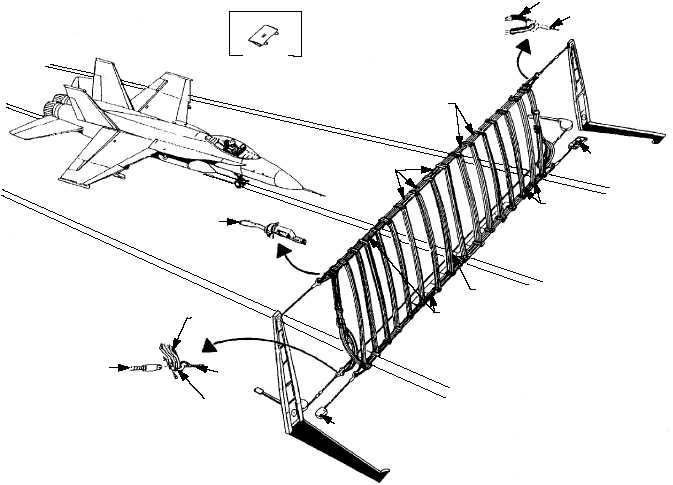Newly constructed barricade webbing assemblies
may be brought out of storage and used as follows:
If used for three practice rigs, it can still be used
as a "ready" barricade for engagements.
If used for four or more practice rigs, it cannot be
used as a "ready" barricade.
When an aircraft is required to make an emergency
landing, the nose of the aircraft passes through the
barricade and allows the vertical (engaging) straps to
contact the leading edges of the wings and wrap about
the aircraft (fig. 3-37). The barricade installation then
passes the force of arrestment through the purchase
cable to the arresting engine. After arrestment, the
barricade and attached hardware are discarded.
Currently, there are two types of barricades (two
configurations) available to the fleet. Both types consist
of all-nylon webbing assemblies, placed one on top of
the other and bundled together to make up one
barricade installation (see fig. 3-36).
The polyurethane semicoated barricade uses three
separate webbing systems to make one main webbing
assembly
Each semicoated barricade webbing system is
composed of upper and lower horizontal load straps
(see fig. 3-36) joined together at the ends by nylon
velcro tie-down straps. (The rolled edges of the upper
and lower load straps are coated with polyurethane to
reduce wear and damage caused when the barricade is
dragged into position for use.)
Vertical engaging straps, are looped around the
upper and lower load strap of each webbing system and
sewn.. The spacing between the vertical engaging
straps affords equalized loading of the barricade during
arrestment. One webbing assembly, effects equalized
loading every 4 feet along the wing's leading edge
3-36
ABE3f0337
RELEASE STRAPS
VELCRO TIE-DOWN
STRAPS
THREE WEBBING
ASSEMBLIES
ANCHOR
ASSEMBLY
ENGAGING STRAPS
REFER TO VIEW A
LOAD STRAPS
EXTENSION
LOOPS
EXTENSION
PENDANT
U-SHACKLE
PARALLEL
PENDANT
WINCH
DECK RAMP
VIEW A
BOOT
PELICAN HOOK
ASSEMBLY
Figure 3-37.—Emergency arrestment.


